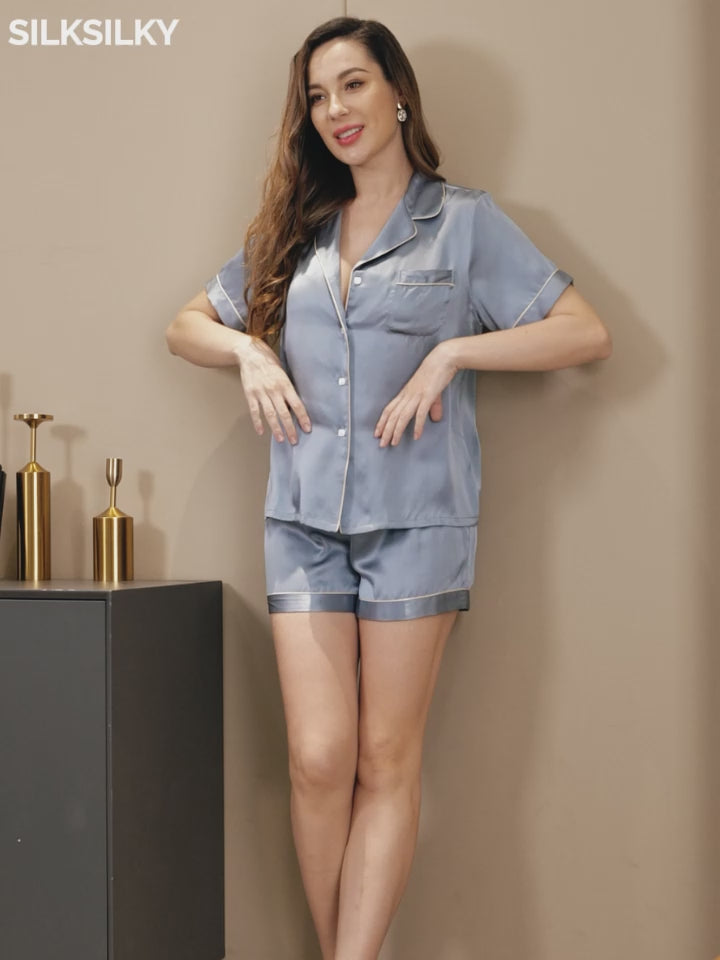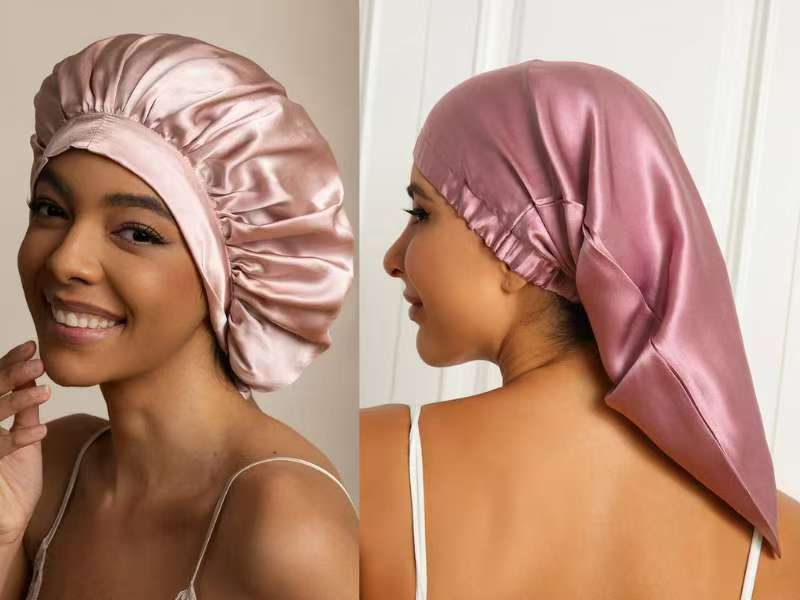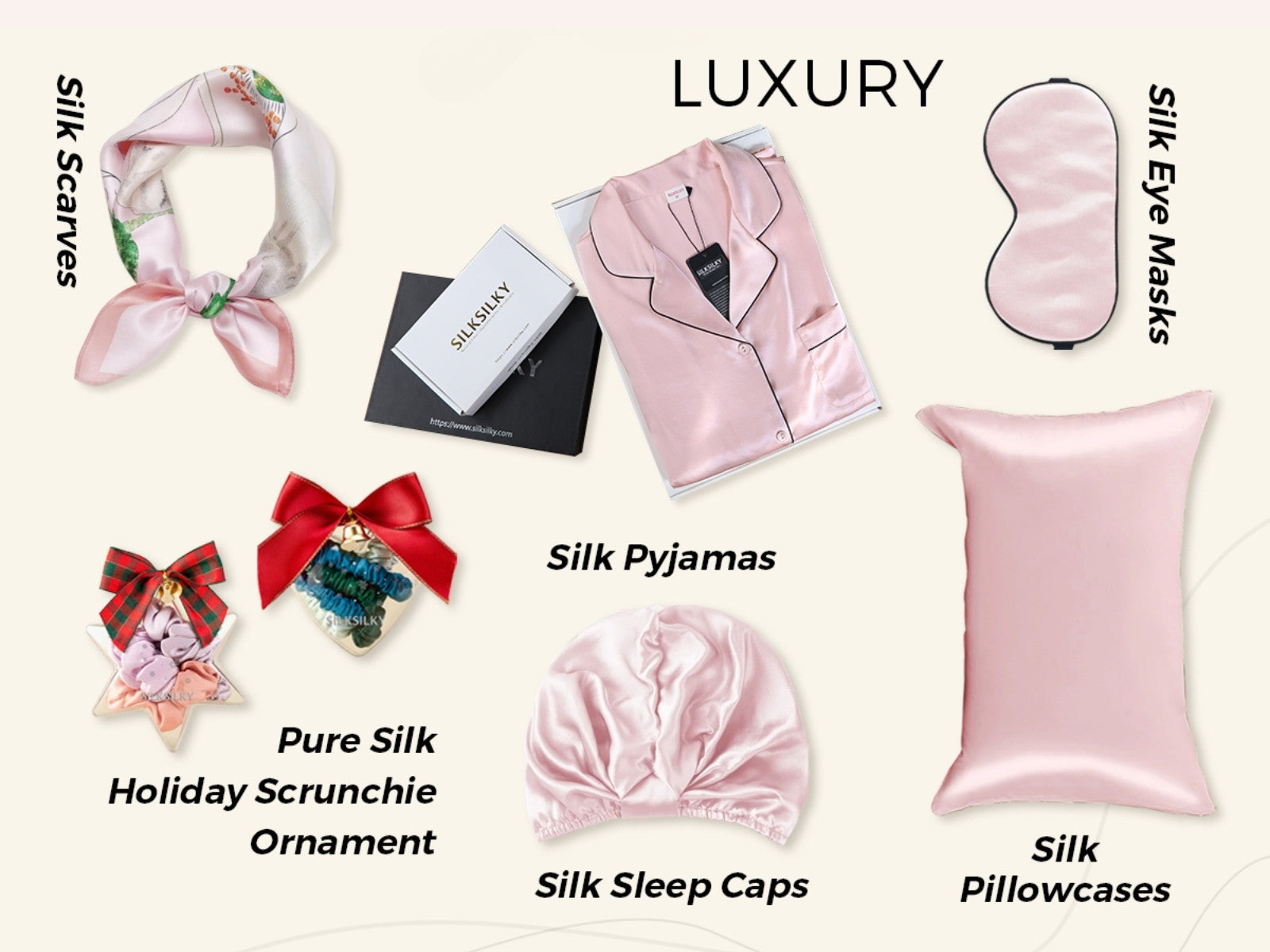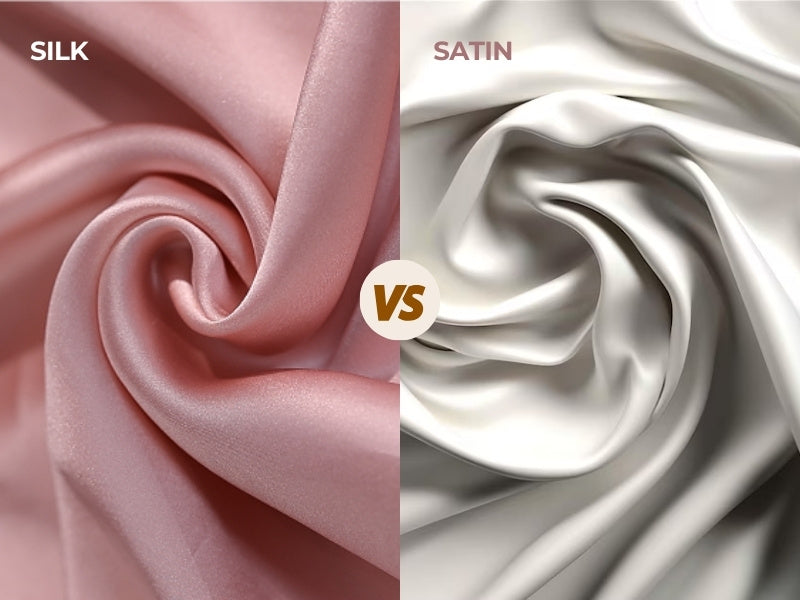Is Investing in Silk Bedding a Good Idea?
Table of Contents
Silk bedding is often considered a luxurious investment due to its elegance and the myriad benefits it offers. Despite its high cost and the special care it requires, many people view silk bedding as a worthwhile purchase. This blog explores the characteristics of silk, reasons behind the high price of silk bedding, its numerous benefits, and answers some frequently asked questions to help you decide if investing in silk bedding is a good idea.
The Characteristics of Silk
Silk, often hailed as the "queen of fabrics," is a remarkable material with unique properties that set it apart from other textiles. Here, we delve deeper into the distinct characteristics of silk, exploring its composition, texture, types, and the processes involved in its production.
1. Composition and Structure
Silk is a natural protein fiber produced by silkworms, primarily the Bombyx mori species. The fiber consists mainly of fibroin, a protein that forms a long, continuous thread. The structure of silk is composed of a series of parallel fibers that are tightly woven together, giving it its characteristic smoothness and strength.
A.Molecular Structure
Silk's molecular structure is composed of long chains of amino acids, which contribute to its smooth and glossy appearance. The amino acids in silk form a crystalline structure that reflects light in a way that creates its signature sheen. This molecular arrangement also imparts strength and durability to the silk fiber, despite its delicate appearance.
B.Smoothness and Luster
The smoothness of silk is attributed to its molecular structure and the way the fibers align. Unlike many other fabrics, silk fibers have a smooth surface that feels soft and luxurious against the skin. The natural luster of silk is a result of the way it interacts with light, creating a subtle, shimmering effect that enhances its visual appeal.
2. Types of Silk
There are several types of silk, each with its own distinct characteristics. Understanding these types can help you choose the right silk bedding or clothing for your needs.
A.Mulberry Silk
Mulberry silk is the most common and highest quality silk, produced by silkworms that feed exclusively on mulberry leaves. This type of silk is known for its smooth texture, strength, and lustrous sheen. It is often used in high-end bedding and clothing due to its superior qualities.
B.Tussah Silk
Tussah silk, also known as wild silk, is produced by silkworms that feed on a variety of leaves, not just mulberry. This type of silk has a more textured surface and a natural, slightly uneven appearance. Tussah silk is generally less expensive than mulberry silk and is often used in more casual or rustic fabrics.
C.Charmeuse Silk
Charmeuse silk is known for its glossy surface and soft drape. It is often used in luxurious bedding and evening wear. Charmeuse silk is characterized by its high sheen and smooth texture, which gives it a rich, elegant appearance.
D.Habotai Silk
Habotai silk, sometimes referred to as "china silk," is a lightweight and relatively inexpensive type of silk. It is often used for linings and summer garments. Despite its lower cost, habotai silk still offers the smooth texture and sheen associated with silk.
E.Satin Silk
Satin silk is not a type of silk but rather a weave that creates a high-shine finish. Satin can be made from various fibers, including silk. When made from silk, satin silk has a glossy surface and a luxurious feel, making it a popular choice for evening wear and formal bedding.
3. Production Process
The production of silk involves several intricate steps, each contributing to the final quality of the fabric.
A.Harvesting Silk
Silk production begins with the cultivation of silkworms. The worms are raised in controlled environments and fed mulberry leaves until they spin their cocoons. The harvesting process involves carefully collecting these cocoons, which are then used to extract the silk fibers.
B.Boiling and Reeling
The harvested cocoons are boiled in hot water to soften the sericin, a protein that holds the silk threads together. This process makes it easier to unspool the continuous threads from the cocoon, a process known as "reeling." The silk threads are then collected and wound onto spools.
C.Spinning and Weaving
Once the silk threads are reeled, they are spun into yarn. This yarn can be woven into various types of fabric, including satin, charmeuse, and organza. The weaving process involves interlacing the yarns to create different textures and patterns.
D.Dyeing and Finishing
Silk fabric can be dyed in a wide range of colors using various methods, including natural and synthetic dyes. After dyeing, the fabric undergoes finishing processes to enhance its texture, sheen, and durability. These finishing techniques can include washing, pressing, and treating the fabric to achieve the desired look and feel.
4. Natural Properties
Silk possesses several natural properties that contribute to its appeal and functionality:
A.Breathability
Silk is a breathable fabric that allows air to circulate, making it comfortable to wear in both warm and cool temperatures. Its natural moisture-wicking properties help regulate body temperature, keeping you cool and dry in the summer and warm in the winter.
B.Strength and Durability
Despite its delicate appearance, silk is a strong and durable fiber. The tensile strength of silk fibers is comparable to that of steel, making silk products surprisingly resilient. However, silk requires gentle handling to maintain its quality over time.
C.Hypoallergenic Qualities
Silk's natural properties make it resistant to dust mites, mold, and other allergens. This hypoallergenic quality makes silk an excellent choice for individuals with allergies or sensitive skin.
D.Moisture Absorption
Silk can absorb up to 30% of its weight in moisture without feeling damp. This property helps to keep the skin hydrated and prevents the buildup of sweat, contributing to a more comfortable sleeping experience.
Why Is Silk Bedding So Expensive?
Silk bedding is prized for its luxury and unique comfort, but its high price often leaves consumers wondering why it costs so much. Understanding the reasons behind the cost of silk bedding can help you better evaluate whether it's worth the investment. Here are the main reasons why silk bedding is so expensive:
1. Labor-Intensive Production Process
A.Silkworm Farming
The production of silk starts with silkworm farming, which is a meticulous and labor-intensive process. Silkworms are raised in controlled environments, and their care requires precise attention to ensure they produce high-quality silk. Farmers must carefully manage environmental conditions like temperature and humidity to maximize silk quality. The amount of time and labor involved in raising the silkworms adds significantly to the cost.
B.Harvesting and Reeling
When silkworms spin their cocoons, the process of harvesting them is delicate. Each silkworm produces only a limited amount of silk, and care must be taken to avoid damaging the silk threads. After harvesting, the cocoons are boiled to soften the sericin (a protein that holds the silk threads together), making it easier to unspool the continuous threads—a process known as "reeling." The technical skill and patience required in reeling silk threads also contribute to the high cost.
2. Quality of Raw Materials
A.Selection of High-Quality Silk
The quality of silk depends on the source of the raw material. The highest quality silk typically comes from silkworms that feed exclusively on mulberry leaves, known for their smooth texture, high luster, and greater durability. The production costs are higher because each silkworm yields a limited amount of silk, and the processing is intricate to maintain high standards.
B.Use of Pure Natural Materials
Silk is a natural fiber, and its production process avoids synthetic additives. Compared to synthetic materials, the cost of natural silk is higher. Additionally, premium silk requires careful selection and treatment to ensure its color and texture meet high standards, which further increases the cost.
3. Production Techniques and Technology
A.Complex Weaving and Dyeing Techniques
The weaving and dyeing processes for silk are complex. Creating intricate patterns and a smooth texture involves high-precision equipment and techniques. Ensuring that colors are even and do not fade requires precise formulations and control. All these sophisticated processes take considerable time and skill, contributing to the overall production cost.
B.Impact of Handcrafting
Some high-end silk bedding still uses traditional handcraft techniques, which not only preserve artisanal skills but also add to the difficulty and time involved in production. Handcrafted silk can offer unique textures and details, but it also significantly raises production costs.
4. Durability and Longevity
A.High Durability
Despite its delicate appearance, silk is a strong and durable fiber. High-quality silk bedding can last for many years with proper care. While the initial cost is high, the durability means the investment can be amortized over the long term.
B.Cost of Maintaining Quality
Maintaining the quality of silk bedding requires careful attention, such as using specialized detergents and gentle washing methods. These additional care requirements increase the overall maintenance costs, affecting the overall economics of silk products.
5. Supply Constraints and Market Demand
A.Production Limitations
Silk production is subject to natural constraints, such as the specific climate conditions required for silkworms to thrive. These limitations affect the supply of silk. The gap between high demand and limited supply drives up the price of silk bedding.
B.Market Positioning
Due to its luxury and high cost, many manufacturers position silk bedding as a high-end product. The high demand for premium silk bedding, coupled with limited supply, results in higher prices. This market positioning reflects the brand and luxury level of the product, contributing to the cost.
6. Brand and Design Impact
A.Brand Premium
Silk bedding from high-end brands often comes with a price premium due to brand reputation. These brands typically use the highest quality silk and incorporate exquisite designs and craftsmanship, adding to the product's value. Brand premiums are a significant factor in the pricing.
B.Customization and Design
Customized silk bedding or products with unique designs tend to be more expensive. Designers' creativity, special craftsmanship, and personalized services add to the cost. Custom silk bedding often requires additional time and materials, which increases the price.
Benefits of Silk Bedding
Silk bed set offers a range of advantages that contribute to its appeal and justify its premium price. From comfort and luxury to practical health benefits, silk bedding provides a unique sleeping experience that is hard to match with other materials. Here’s an in-depth look at the many benefits of silk bedding:
1. Luxurious Comfort
A.Softness and Smoothness
One of the most immediate benefits of silk bedding is its unparalleled softness and smooth texture. The natural fibers of silk create a surface that feels incredibly gentle against the skin, enhancing the overall comfort of your sleep environment. Unlike other fabrics, silk’s smoothness reduces friction, which helps to prevent irritation and discomfort.
B.Breathability
Silk is a breathable fabric, meaning it allows air to circulate freely. This property helps in maintaining an optimal sleeping temperature by preventing overheating. Silk’s natural ability to regulate temperature ensures that you stay cool and comfortable in warmer months and warm and cozy in cooler months.
2. Temperature Regulation
A.Moisture-Wicking Properties
Silk has excellent moisture-wicking abilities, which means it can absorb and release moisture efficiently. This helps in keeping the bed dry and comfortable, reducing the likelihood of waking up due to excessive sweating or feeling cold. By managing moisture effectively, silk bedding contributes to a more restful and uninterrupted sleep.
B.Insulating Qualities
Silk’s natural insulating properties help to trap air close to your body, providing warmth without the bulkiness often associated with other insulating materials. This means silk bedding offers effective temperature regulation, keeping you warm during the winter and cool during the summer.
3. Hypoallergenic Benefits
A.Resistance to Allergens
Silk is naturally resistant to dust mites, mold, and other common allergens. Its smooth surface does not provide a conducive environment for allergens to settle, making it an ideal choice for those with allergies or sensitive skin. By reducing exposure to allergens, silk bedding can help alleviate allergy symptoms and improve overall sleep quality.
B.Anti-Microbial Properties
Silk has natural anti-microbial properties that help prevent the growth of bacteria and fungi. This is particularly beneficial for maintaining a clean and hygienic sleep environment, as silk bedding tends to stay fresher for longer periods compared to other fabrics.
4. Benefits for Skin and Hair
A.Skin Hydration
Silk is known for its ability to help retain moisture. When you sleep on silk bedding, your skin benefits from its hydrating properties, as silk helps to prevent moisture loss from your skin. This can lead to improved skin health and a reduction in the appearance of fine lines and wrinkles.
B.Hair Care
Silk bedding is also advantageous for your hair. The smooth surface of silk reduces friction, which helps to minimize hair breakage and split ends. Unlike cotton, which can absorb moisture from your hair, silk helps to maintain your hair’s natural oils, leaving it softer and less prone to frizz.
5. Durability and Longevity
A.Strength of Silk Fibers
Despite its delicate appearance, silk is remarkably strong and durable. The tensile strength of silk fibers is comparable to that of steel, which means silk bedding can withstand regular use without losing its integrity. With proper care, silk bedding can last for many years, making it a durable investment.
B.Timeless Appeal
Silk bedding maintains its elegant appearance over time. The natural sheen and smooth texture of silk do not diminish with repeated use, and its luxurious feel remains intact. This long-lasting appeal ensures that silk bedding continues to provide comfort and style for years to come.
6. Ease of Maintenance
A.Low Maintenance Requirements
While silk bedding does require gentle care, it is relatively easy to maintain compared to its luxurious appearance. Silk can be hand-washed or dry-cleaned, and many silk products are now available with easy-care finishes. Regular cleaning according to care instructions ensures that silk bedding remains in excellent condition.
B.Stain Resistance
Silk is naturally stain-resistant due to its smooth surface, which prevents stains from penetrating deeply into the fibers. In case of spills or stains, they can often be treated more easily on silk compared to more absorbent fabrics. Prompt attention to stains helps maintain the pristine look of silk bedding.
7. Environmental Considerations
A.Eco-Friendly Production
Silk is a natural and biodegradable fiber, making it an environmentally friendly choice compared to synthetic fabrics. The production of silk has a lower impact on the environment, especially when compared to petrochemical-based fibers. Choosing silk bedding supports sustainable practices and reduces your ecological footprint.
B.Renewable Resource
Silk is produced from the cocoons of silkworms, which can be harvested sustainably. The process of collecting silk does not harm the silkworms, and they are often reared in a controlled environment where their lifecycle is managed carefully. This renewable resource contributes to the sustainability of silk bedding.
Frequently Asked Questions About Silk Bedding
A.How should I care for silk bedding?
Silk bedding requires special care to maintain its quality. It is recommended to hand wash or use a gentle cycle with cold water if machine washing. Use a mild detergent specifically designed for silk. Avoid wringing or twisting the fabric, and instead, lay it flat to dry. If dry cleaning, ensure the cleaner uses a process suitable for silk.
B.Can silk bedding be machine washed?
Yes, but with caution. Always check the care instructions provided by the manufacturer. Use a gentle cycle and cold water to prevent damage. Consider placing the bedding in a mesh bag to protect it from potential snags or tears.
C.How do I choose the right type of silk for bedding?
Mulberry silk is often the preferred choice for its superior quality and hypoallergenic properties. However, Tussah silk and Charmeuse silk can also be good options depending on your budget and preferences. Consider the weight, texture, and sheen of the silk to match your desired feel and appearance.
D.Is silk bedding worth the investment?
Whether silk bedding is worth the investment depends on individual preferences and priorities. The benefits of silk, such as its hypoallergenic properties, temperature regulation, and skin and hair health benefits, make it a worthwhile investment for many people. However, the high cost and maintenance requirements should be considered. If you value luxury and are willing to invest in a long-lasting product, silk bedding can be a great choice.
Conclusion
Silk bedding, with its luxurious feel, hypoallergenic properties, and temperature regulation, offers numerous benefits that can enhance your sleep quality and overall well-being. Despite its high cost and the special care it requires, many find that the advantages of silk justify the investment. The labor-intensive production process, quality of raw material, and limited supply contribute to its premium price, but these factors also ensure a durable and elegant product. If you are looking for a luxurious upgrade to your bedroom that combines comfort and style, silk bedding might be a worthy investment.
![[Light Blue] SilkSilky Pure Silk Notch Collar Women's Pajamas 001,](http://silksilky.com/cdn/shop/files/ab83afb9301666ee2f174a8ae72ffda4_4e9bb488-7880-40fe-9e69-f0fd823857c5.jpg?v=1764653199&width=1200)
![[Light Blue] SilkSilky Pure Silk Notch Collar Women's Pajamas 002,](http://silksilky.com/cdn/shop/files/db8dbeee5354fe3b631b963715847ffe.jpg?v=1764653202&width=1200)
![[Dark Red] SilkSilky Pure Silk Notch Collar Women's Pajamas 001,](http://silksilky.com/cdn/shop/files/599ed0811e1a5fcfa55bdc80a0279704_2643c850-a793-4475-a52b-7fef1bbd7e36.jpg?v=1762233837&width=1200)
![[Dark Red] SilkSilky Pure Silk Notch Collar Women's Pajamas 002,](http://silksilky.com/cdn/shop/files/9e022d4dd4f99aed4af8da3f58fcfd5b_efb9bafe-3d71-4283-9b81-e339ff08f352.jpg?v=1762233837&width=1200)
![[White] SilkSilky Pure Silk V Neck Nightgown 001,](http://silksilky.com/cdn/shop/files/a8ae95260a57844b1e2e00c4fcfabdcc_b922b270-af10-4e96-9493-0d877bd663db.jpg?v=1764140639&width=1200)
![[White] SilkSilky Pure Silk V Neck Nightgown 002,](http://silksilky.com/cdn/shop/files/24ac506750f8c38c51bb5b6d0ee15287.jpg?v=1764140639&width=1200)
![[Pink] SilkSilky Pure Silk Sleep Cap 001,](http://silksilky.com/cdn/shop/files/SilkSilky_Pure_Silk_Sleep_Cap_Pink_001_C-250529006.jpg?v=1762221980&width=1200)
![[Pink] SilkSilky Pure Silk Sleep Cap 002,](http://silksilky.com/cdn/shop/files/SilkSilky_Pure_Silk_Sleep_Cap_Pink_002_C-250529006.jpg?v=1762221980&width=1200)
![[Steel Blue] SilkSilky Pure Silk Notch Collar Women's Pajamas 001,](http://silksilky.com/cdn/shop/files/05b358f92fb5d252122b00d69a2fcfc5_88211a42-88c4-4448-8cb3-5f18529bfef8.jpg?v=1762237226&width=1200)












